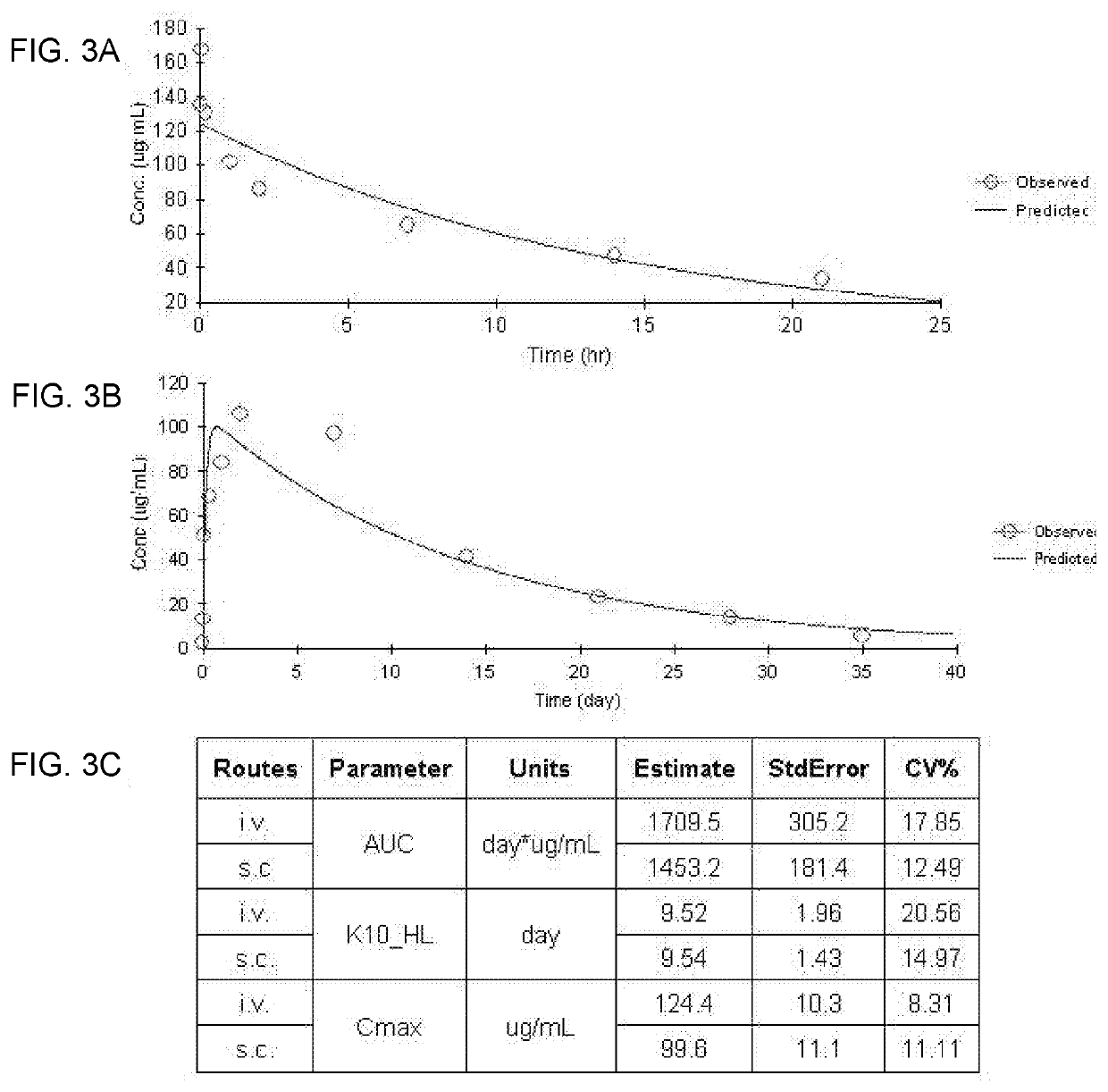Methods of use of soluble cd24 for neuroprotection and remyelination
a neuroprotective and remyelination technology, applied in the field of neuroprotective and remyelination methods, can solve the problems of more progressive disease forms, axons permanently demyelinated and vulnerable to degeneration, and the reason for remyelination failure in diseases such as ms is still not fully understood, so as to promote myelination, promote the conversion of oligodendrocytes, and promote myelin production
- Summary
- Abstract
- Description
- Claims
- Application Information
AI Technical Summary
Benefits of technology
Problems solved by technology
Method used
Image
Examples
example 1
CD24 Pharmacokinetics in Mice
[0061]1 mg of CD24Fc (CD24Fc) was injected into naïve C57BL / 6 mice and collected blood samples at different timepoints (5 min, 1 hr, 4 hrs, 24 hrs, 48 hrs, 7 days, 14 days and 21 days) with 3 mice in each timepoint. The sera were diluted 1:100 and the levels of CD24Fc was detected using a sandwich ELISA using purified anti-human CD24 (3.3 μg / ml) as the capturing antibody and peroxidase conjugated goat anti-human IgG Fc (5 μg / ml) as the detecting antibodies. As shown in FIG. 3A. The decay curve of CD24Fc revealed a typical biphase decay of the protein. The first biodistribution phase had a half-life of 12.4 hours. The second phase follows a model of first-order elimination from the central compartment. The half-life for the second phase was 9.54 days, which is similar to that of antibodies in vivo. These data suggest that the fusion protein is very stable in the blood stream. In another study in which the fusion protein was injected subcutaneously, an alm...
example 2
CD24-Siglec 10 Interaction in Host Response to Tissue Injuries
[0062]Nearly two decades ago, Matzinger proposed what was popularly called danger theory. In essence, she argued that the immune system is turned on when it senses the dangers in the host. Although the nature of danger was not well defined at the time, it has been determined that necrosis is associated with the release of intracellular components such as HMGB1 and Heat-shock proteins, which were called DAMP, for danger-associated molecular patterns. DAMP were found to promote production of inflammatory cytokines and autoimmune diseases. In animal models, inhibitors of HMGB1 and HSP90 were found to ameliorate RA. The involvement of DAMP raised the prospect that negative regulation for host response to DAMP can be explored for RA therapy.
[0063]Using acetaminophen-induced liver necrosis and ensuring inflammation, it was observed that through interaction Siglec G, CD24 provides a powerful negative regulation for host response...
example 3
Binding of CD24Fc with Myelin Associate Glycoprotein (MAG) In Vitro
[0065]Myelin Associate Glycoprotein (MAG), also known as Siglec-4, is a member of the Siglec family that recognizes sialic acid-containing structures and is expressed on the axons of neurons and functions as a negative regulator for axon outgrowth and neuron-regeneration. MAG protein is conserved between mice and humans allowing the testing of CD24Fc in mouse models. In order to confirm binding of CD24Fc to MAG, recombinant MAG-Fc fusion protein comprising the extracellular domain of rat MAG fused by means of a polypeptide linker to the carboxyl-terminal Fc region of human IgG1 was used (Sigma product number M 5063). The extracellular domain of human MAG (Genbank accession number NP_002352) and rat MAG (Genbank accession number NP_058886) are 96% identical.
[0066]The interaction of CD24Fc with MAG was detected by Biacore surface plasmon resonance (SPR) assay. Briefly, both CD24Fc and human IgG Fc control were biotinyl...
PUM
| Property | Measurement | Unit |
|---|---|---|
| Temperature | aaaaa | aaaaa |
| Mass | aaaaa | aaaaa |
| Mass | aaaaa | aaaaa |
Abstract
Description
Claims
Application Information
 Login to View More
Login to View More - R&D
- Intellectual Property
- Life Sciences
- Materials
- Tech Scout
- Unparalleled Data Quality
- Higher Quality Content
- 60% Fewer Hallucinations
Browse by: Latest US Patents, China's latest patents, Technical Efficacy Thesaurus, Application Domain, Technology Topic, Popular Technical Reports.
© 2025 PatSnap. All rights reserved.Legal|Privacy policy|Modern Slavery Act Transparency Statement|Sitemap|About US| Contact US: help@patsnap.com



